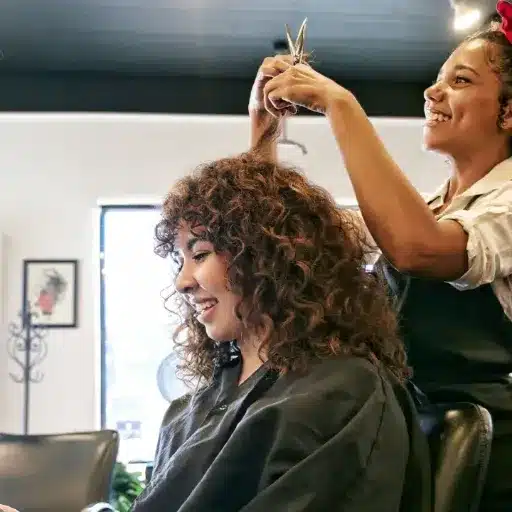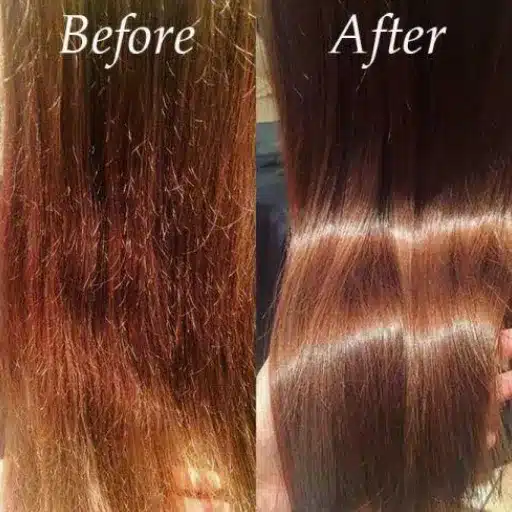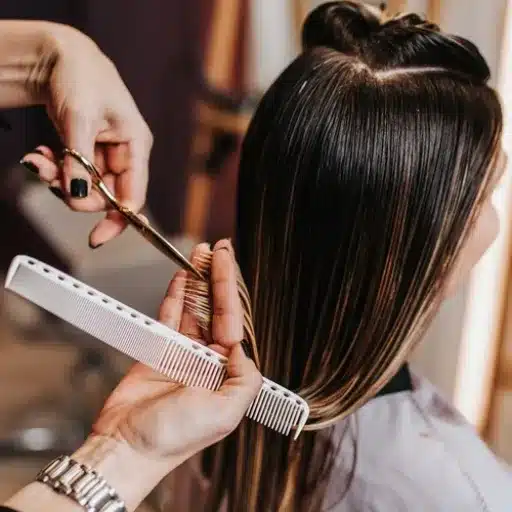Achieving a perfect haircut for curly hair can be challenging, especially when the age-old question arises: wet or dry? Curly hair cutting methods will significantly influence the shape, definition, and overall appearance of the hair, one of the most critical decisions that individuals want to make to let their natural work shine. We explore the science and techniques, as well as the differences between wet and dry haircuts for curly hair, and consider the advantages and disadvantages of each method. This comprehensive guide will provide a stylist with professional insight or a client with guidance before their next appointment.
Understanding Curly Hair

This unique hair structure is dependent on the hair follicle. Contrary to straight hair, curly strands are generated from oval-shaped or asymmetrical follicles- the more the curves, the more the hair follicle. It is just this curly structure that interferes with the even distribution of external layers and natural oils, which causes dryness in curly hair and, hence, frizzing. Very gentle care, promoting a soft and healthy appearance, is required to maintain the curl shape and prevent damage. This includes moisturizing treatments and gentle handling. With a basic understanding of how these products work, making the right choice for cut and care of curly hair would be easy.
Characteristics of Curly Hair
Curly Hair is usually distinguished by its structure that can range from loose waves to tight coils. This shape is a result of the somewhat oval or asymmetrical shape of the hair follicle in contrast to straight hair follicles. Curl patterns are often categorized by numbers, such as 2 (wavy), 3 (curly), and 4 (coily), which are then further classified by subtypes that are more specific about curl tightness and texture. Curly hair, by the way, also tends to dry out because as the natural oil from the scalp has a difficult time travelling downhill through the twists and loops of the hair. Hence, frizz and breakage are common issues faced by individuals with curly hair. A proper regimen typically includes sulfate-free shampoos, moisturizing conditioners, and the avoidance of heat styling to preserve the curls and prevent damage.
Different Curl Patterns
1. Type 2 (Wavy Hair)
- 2A: Fine, loose waves with little to no definition.
- 2B: Waves prone to frizz form more defined “S” shapes.
- 2C: Coarse and thick waves with greater strength and prominence of the “S” patterns.
2. Type 3 (Curly Hair)
- 3A: Big loose curls with a soft feel and ample shine.
- 3B: Bouncy curly hair in tighter curls with coarse texture.
- 3C: Corkscrews, very dense, tight curls, and plenty of volume.
3. Type 4 (Coily Hair)
- 4A: Tight coils forming clear “S” or springy patterns.
- 4B: Zig-zaggestures, less well-defined curls, with soft, fluffy texture.
- 4C: Very tight, densely packed coils that may not form a clearly defined curl pattern but are very much prone to shrinkage.
How Texture Affects Haircuts
Hair texture is crucial to the haircut result since it defines the shape, movement, and style. Thin hair generally tends to lie flat, for which a layering or texturizing technique is used to produce some volume and dimension. Medium to wavy hair textures are adaptable and allow for a multitude of styles that retain basic form while enhancing the natural movement of the hair. Hair with a coarse or curly texture requires precision, as every curl reacts differently to cutting. Therefore, it is often cut while dry to shape the curls in their natural form. Since each texture behaves differently, the haircuts are designed not only to enhance the individual’s face but also to accentuate the characteristics of the hair itself. Therefore, proper evaluation of texture is vital for a well-balanced and elegant result.
Wet vs. Dry Haircuts: An Overview

Wet and dry haircuts aim for different results and offer various advantages depending on the desired outcome and the type of hair. Wet cutting, being the traditional method, is ideal for precision and uniformity, especially with straight or fine hair, where the cuts, lines, or shapes need to be exact. This method allows sectioning to be controlled and is especially good at smooth sleek styles, with sharply defined edges. Conversely, dry cutting works with the way hair behaves: it is much more beneficial for textured, curly, or wavy types. The dry cutting method ensures that the final shape corresponds with how the hair behaves in its natural state. Hence, it improves volume and movement. Therefore, depending upon each hair texture and the stylist’s experience, the decision between a wet or dry style must be made. Actually, the best way to utilize these two methods is to combine them to achieve a well-balanced, professional finish.
What is a Wet Haircut?
A wet haircut involves washing and cutting the hair while it is damp or wet. This traditional method allows for more precise and accurate cutting, as the hair lies flat and is easier to section. Cutting wet is considered best for creating sharp lines and edges, particularly when using blunt cuts, layered cuts, or hairstyles that require precise details. According to the latest data pulled from Google’s search engine, “what is a wet haircut” has been steadily gaining in queries, indicating a wider interest on the general public about this technique. This could mean that more people are searching to understand what advantages it holds in clasping symmetrical custom-shaped cuts with less struggle or resistance. Wet haircuts are also most suited for preparing hair for chemicals such as color or perming, because the hair saturates evenly for consistent results.
What is a Dry Haircut?
A dry haircut is a technique in which a stylist cuts hair while it remains entirely dry, allowing for complete visibility of its natural texture, behavior, and fall. Whereas wet haircuts work based on damp strands, dry haircuts allow the stylist to fully tailor shapes to suit the individual hair type, whether fine, curly, wavy, or straight, thereby promoting much more heightened customization of styles or refinement of details in short haircuts. At times, it is an effective method of reducing shrinkage and surprises after a cut, hence earning its trust amongst stylists who are very precise and align with customer preferences.
Key Differences Between Wet and Dry Cutting Methods
The key differences between wet and dry cutting methods for curly hair lie in precision, visualization, hair texture management, shrinkage control, and styling outcome.
Advantages of Cutting Curly Hair Wet

1. Precision of Shape
Cutting curly hair while it’s wet allows the stylist to have precise control over shaping and achieving uniformity, especially when working with styles that require a clean line or polished symmetry.
2. Sectioning and Control
Wet hair is much easier to section, comb, and hold, ensuring the stylist has perfect control over each subsection during the cutting process.
3. Detangling
Wet hair tangles less compared to dry hair, making parting and cutting easier, especially if the texture is dense or coily.
4. Blending of Layers Equally
The wet method of cutting provides a smooth blend as it eliminates inconsistencies caused by the varying springbacks of dry curls.
Although wet cutting is more suitable for certain haircuts or finishes, a skilled stylist will pay special attention to shrinkage and the natural curl pattern once the hair is dry.
Precision in Cutting
Precision cutting refers to any cutting process done with utmost attention to detail and a precise technique to achieve an almost perfect, customized result that is truly tailored to the client. Working with wet hair gives the stylist the greatest opportunity to control sectioning and lines of cutting, allowing for clean and symmetrical finishes to be achieved. It allows the stylist to make more refined adjustments and eliminate errors caused by the limitations imposed by uneven tensile strengths or the variability of texture checks in individual strands of their work. From the cutting of geometric patterns in intricate depths to very simple well-blended layer work, every other form of precise cut will ensure that the desired look is attainable in all cases.
Ease of Handling
The condition of wet hair proves convenient to handle during styling, mainly due to a greater degree of elasticity and compliance it exhibits at such time. This brings about smoother sectioning without losing hold of detangling control or compromise on tension maintained during cutting. These factors would go a long way in serving the interests of attenuating errors in executing either complicated styles or evenly distributed trim, with the added advantage of lessening strain exerted on hair and styling tools by the stylist.
Impact on Curl Definition
Styling wet hair has a significant influence on curl definition and promotion. These products, such as curl creams, gels, or mousses, are best applied evenly to wet hair, which helps maintain and enhance its natural curl definition. Naturally, curls tend to clump more on wet hair because the dampness helps keep frizz at bay and keeps strands together. Water also acts as a temporary weight, stretching out curls for a short while, making it easier to work on shaping them and enhancing the pattern before drying. This allows for maximum retention of the natural pattern, thereby making wet styling the preferred option for imparting evenness and definition to curls.
Advantages of Cutting Curly Hair Dry

The stylist sees the real thing—the hair’s length, shape, and natural curl pattern, as well as how it presents itself, actually affected by water. Thus, there will again be precision in how a stylist assesses how the curls will fall after they are styled, minimizing surprises on the final result. It works well to correct for discrepancies in degenerative distributions or unusual patterns and apply adjustments to fit one hair’s specific curl structures. One drawback, theoretically, of wet hair cutting is that it can be overcut since wet hair appears longer than dry hair due to temporary elongation. In contrast, the dry-cutting method genuinely preserves the hair’s natural texture and gives it a balanced shape that is conducive to harmonizing with the natural texture.
True Curl Pattern Visibility
Good visibility of the actual curl pattern is thus linked with its natural dry state. When the hair is cut dry, this ensures the unaltered behavior, texture, and shape of the curls can be assessed by the stylist. Temporary straightening of the curls due to the weight of water on wet hair disguises this proper form and makes it almost impossible to foresee how the hair will sit after drying. Working with the hair’s natural state allows for accurate measurement of curl distribution, volume, and movement, enabling good results and tailored styling.
Less Shrinkage and Better Texture Understanding
When hair is cut dry, shrinkage is less of a concern because the hair is being cut at its natural length when fully dry; this provides an accurate measure of how the hair will look when styled. This is good for curly and wavy hair because it allows stylists to work with the hair’s natural texture. Cutting hair dry prevents others from compensating too much for shrinkage, which is very often done when hair is cut wet, as the hair only reveals its real length or curl pattern upon drying. Additionally, dry-cutting enables stylists to observe variations in texture and curl patterns throughout the hair, providing a more precise interpretation and customization for a cut that complements the hair’s natural traits. This method ultimately balances shape, volume, and movement into a presentation that is pleasing to both functional and visual aesthetics.
Expert Opinions from Stylists

The choice to cut curly hair wet or dry depends significantly on the look the client wants to achieve and the hair’s unique characteristics. Many stylists prefer cutting curly hair dry, as it allows them to observe the natural shape, movement, and shrinkage of the curls, resulting in a more accurate and personalized haircut. Cutting the hair when it is wet is preferable when creating even layers or working with heavier textures, as moisture lends to better control. Ultimately, the decision for hair cutting is dependent on stylist techniques, hair type, and client expectations.
Why Some Stylists Prefer Wet Cuts
Cutting wet hair maximizes control and precision, particularly when working with thick, coarse, or straight types of hair. Sections are cut smoothly, allowing for the creation of even lines and lengths. This technique is favored, especially for styles such as blunt cuts or layered ones, where the weight of water elongates the strands ensuring accuracy. Also, cutting hair when it’s wet can help reduce frizz and make manageability easier for hair that tangles and resists even sectioning when dry. Stylists favor this method in preparing versatile, structured, and polished results.
Why Others Advocate for Dry Cuts
Dry haircuts tend to reveal the natural fall and movement of the hair, so the stylist can make minute corrections as the hair behaves naturally. This way, stylist work on textured, wavy, or curling hair to satisfy the pattern of a curl or a wave. Dry cuts allow one to take away weight and amassing more control over removing shape, especially layered or highly customized styles. Some clients will also prefer dry cutting so that they have a better sense of the end right through the process.
Emerging Trends in Curly Hair Care
The care and styling of curly hair are constantly evolving, pushed by the interlacing of the formulation landscape and scientific understanding of curl behavior. One of the big trending topics is that of specialized curly hair products implicating all things sulfate-free cleaners and silicone-free conditioners, which are supposed to lock in moisture and maintain the hair’s natural integrity. The “Curly Girl Method” itself, which broadly rejects heat and harsh chemicals, remains in wide use, while its various offshoots have gained traction for allowing more fine-tuning. Another trending topic focuses on scalp health, offering products that provide both exfoliation and hydration to promote curl growth while addressing build-up or dryness. Additionally, there is a desire for formal education, such as stylists obtaining certification in curl-specific techniques, to ensure they achieve better results tailored to an individual’s curl type. Sustainability- and eco-friendliness-centered product development is also gaining momentum, with some companies opting for biodegradable packaging and natural ingredients.
Reference Sources
-
Our approach / dry vs. wet cutting – Discusses the differences between wet and dry cutting for curly hair, including the impact on shape and frizz.
-
Is it better to cut your hair wet or dry when you have curly hair? (Quora) – Highlights the benefits of dry cutting for curly hair, considering shrinkage factors.
-
5 Rules For Cutting Curly Hair | Curl Talk (Ouidad) – Discusses the Ouidad Carve and Slice technique, which is performed on wet hair.
-
How to Cut Curly Hair: 5 Golden Rules (Prose) – Provides insights into why dry hair trims are often preferred for curly hair, focusing on individual curl patterns.
Frequently Asked Questions (FAQs)
Should One Cut Curly Hair When It Is Wet or Dry?
This question is oriented toward both personal preference and the type of cutting technique used. Many curly-haired persons will advise that to have an exact image of how their curls will look upon styling, their hair is to be cut dry. On the other hand, for some hairdressers, the opposite could be true, as they believe that cutting when wet allows for a cleaner cut and more accurate judgment on length.
What Is the Best Way To Cut Curly Hair?
Most times, the best way to cut curly hair tends toward a dry cut, as it allows stylists to see how the curls lay naturally. This helps to avoid giving hair the frizzy or uneven look it tends to assume sometimes when cut wet. Additionally, a technique that is not straight across, but rather a snipping method, can help promote a natural look.
Can I Cut Curly Hair at Home?
You can cut curly hair at home, but you have to do it carefully. If considering a DIY cut, use the dry cut method, so you can see how your curls fall after the cut. When measuring, always pull the hair straight but avoid cutting too much at one time to avoid creating an uneven look.
What Cutting Method Will Most Suit My Curly Hair?
Several cutting techniques suit curly hair well, including the Deva cut, which is specially designed for curly hair types. This cutting technique is often applied with the curls cut dry, allowing the stylist to see how each curl behaves. Other cutting techniques, such as the “twist and snip” method, can also help form well-defined ringlets and reduce frizz.
How Do I Style My Hair after Curly Haircut?
Ordinarily, once you are done with your haircut, you can style curly hair with the help of some products. A leave-in conditioner is ideal for hydrating your curls, and using a diffuser will help enhance your natural curl pattern. Scrunching is the way to go. Pulling hair straight is not the best option, as it may result in a relatively flat look.
What Is to Keep in Mind Before Cutting the Curly Hair?
Before cutting your curly hair, consider its length and natural curl pattern. Getting in touch with your hairdresser and talk about how you wear it curly, what you aim to do, will lead to a discussion that makes it more certain they choose a suitable cutting technique for achieving your look.






